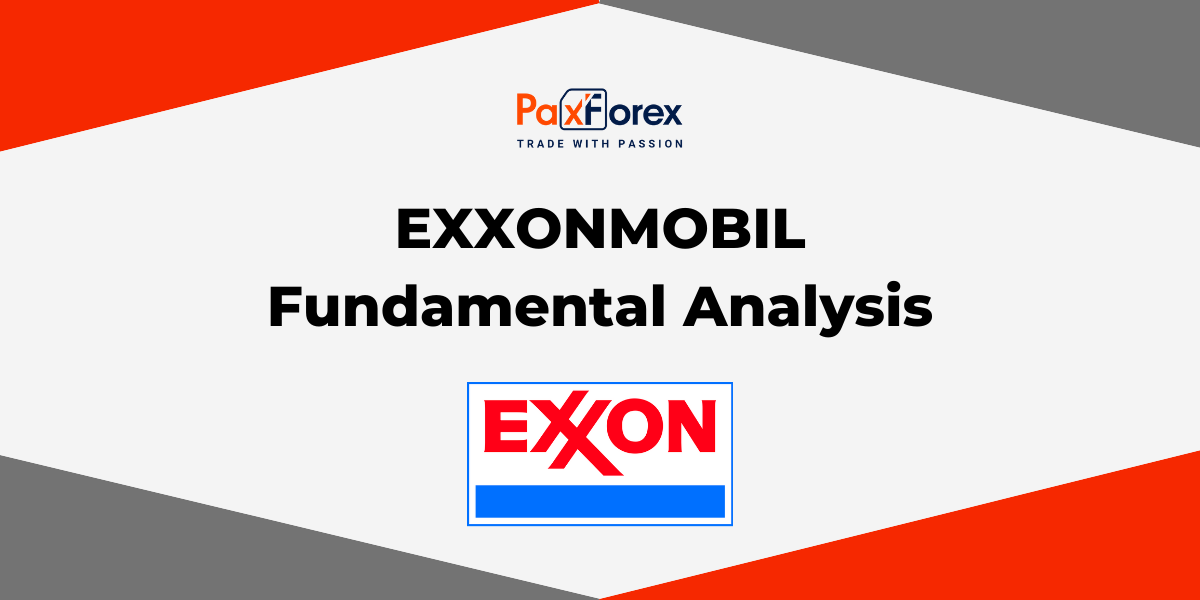
Source: PaxForex Premium Analytics Portal, Fundamental Insight
ExxonMobil | Fundamental Analysis
ExxonMobil, traditionally a major player in the production of carbon-intensive fossil fuels, is undergoing a transformative shift that could reshape its financial landscape by the end of this decade. With an increasing commitment to mitigating emissions and diversifying into lower-carbon ventures, the oil giant anticipates substantial returns on these investments by 2030. In a recent update to its corporate plan, ExxonMobil outlined a pivotal aspect of its strategy focused on emissions reduction, targeting both its own emissions and those generated by its customers. The company is set to channel over $20 billion into initiatives with lower emissions, marking a $3 billion increase from the previous year and the third consecutive boost in its lower-carbon spending plan over the past three years.
Diversification efforts are integral to ExxonMobil's new approach, allocating approximately half of the capital towards curbing its corporate emissions, with a specific goal of achieving net zero emissions from its Permian Basin assets by 2030. Further, the company aims to expedite Pioneer Natural Resources' timeline to achieve net zero in the region, now set for 2035. Aiming for a significant impact, ExxonMobil also plans to curtail its global methane emissions by 70%-80% by 2030, while striving for net zero emissions across its global operations by 2050.
In tandem with emission reduction, ExxonMobil is actively investing the remaining half of its capital into emerging lower-carbon technologies. These strategic ventures encompass areas such as lithium, hydrogen, biofuels, and carbon capture and storage. The company envisions that these forward-looking businesses could collectively contribute to a reduction of over 50 million metric tons of global emissions annually by 2030. To contextualize this impact, it is equivalent to replacing approximately 17.5 million gas-powered cars with electric vehicles (EVs). As ExxonMobil forges ahead with these initiatives, the company is positioning itself to play a significant role in shaping a more sustainable and diversified future, creating potential value for its shareholders in the years to come.
ExxonMobil's commitment to transitioning into a lower-carbon future is underscored by its disciplined investment strategy, a calculated move geared not only towards corporate responsibility but, critically, to secure robust returns on capital. The company projects an estimated return of around 15% from its investments in expanding lower-carbon solutions. While this figure falls below the impressive returns derived from its traditional oil and gas ventures (approximately 30%), a 15% return remains formidable. Moreover, certain projects within ExxonMobil's diverse portfolio, particularly the dozen biofuel initiatives in progress, are anticipated to yield returns surpassing 20%.
Significant strides have been made in the past year as part of ExxonMobil's lower-carbon energy strategy. The strategic acquisition of Denbury Resources for $4.9 billion has substantially bolstered the company's carbon capture and storage capabilities, culminating in the possession of the largest carbon dioxide pipeline network in the country. ExxonMobil envisions carbon capture and storage solutions evolving into a multibillion-dollar annual revenue stream, characterized by stability due to long-term contractual agreements, mitigating the inherent volatility of its oil and gas operations.
In a strategic move towards lithium production, ExxonMobil aims to position itself as a leading lithium producer by 2030. The company has secured land in Arkansas, rich in lithium deposits, and anticipates commencing lithium production for electric vehicle (EV) batteries by 2027. This venture aligns with ExxonMobil's ambition to produce sufficient lithium by 2030 to meet the needs of one million EVs annually.
The commitment to lower-carbon solutions is further underscored by an additional $3 billion injection into ExxonMobil's investment plan, reinforcing the potential for future returns from an array of lower-carbon businesses. These initiatives are poised to evolve into significant growth drivers, enhancing ExxonMobil's long-term investment appeal by positioning the company for success in an increasingly lower-carbon world.
As long as the price is below 105.00, follow the recommendations below:
- Time frame: D1
- Recommendation: short position
- Entry point: 98.29
- Take Profit 1: 95.00
- Take Profit 2: 90.00
Alternative scenario:
If the level of 105.00 is broken-out, follow the recommendations below:
- Time frame: D1
- Recommendation: long position
- Entry point: 105.00
- Take Profit 1: 109.00
- Take Profit 2: 113.00













